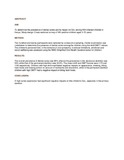| dc.description.abstract | AIM:
To determine the prevalence of dental caries and its impact on QoL among HIV-infected children in Kenya. Study design: Cross-sectional survey of HIV-positive children aged 3-15 years.
METHOD:
Two hundred and twenty participants were selected by consecutive sampling. Dental examination was undertaken to determine the presence of dental caries among the children using the dmft/DMFT indices. The children's perceived QoL in the domains of oral symptoms, functional limitations, emotional and social wellbeing was assessed using the WHO Simplified Oral Health Questionnaires for children.
RESULTS:
The overall prevalence of dental caries was 65% whence the prevalence in the deciduous dentition was 50% while that of the permanent dentition was 30.9%. The mean dmft and DMFTscores were 1.75 and 1.08 respectively. Children with high dmft manifested negative impacts on appearance, chewing, biting hard foods and missing school on account of toothache and discomfort, while in the permanent dentition children with high DMFT had a negative impact on biting hard foods.
CONCLUSION:
A high caries experience had significant negative impacts on the children's QoL, especially in the primary dentition | en_US |

